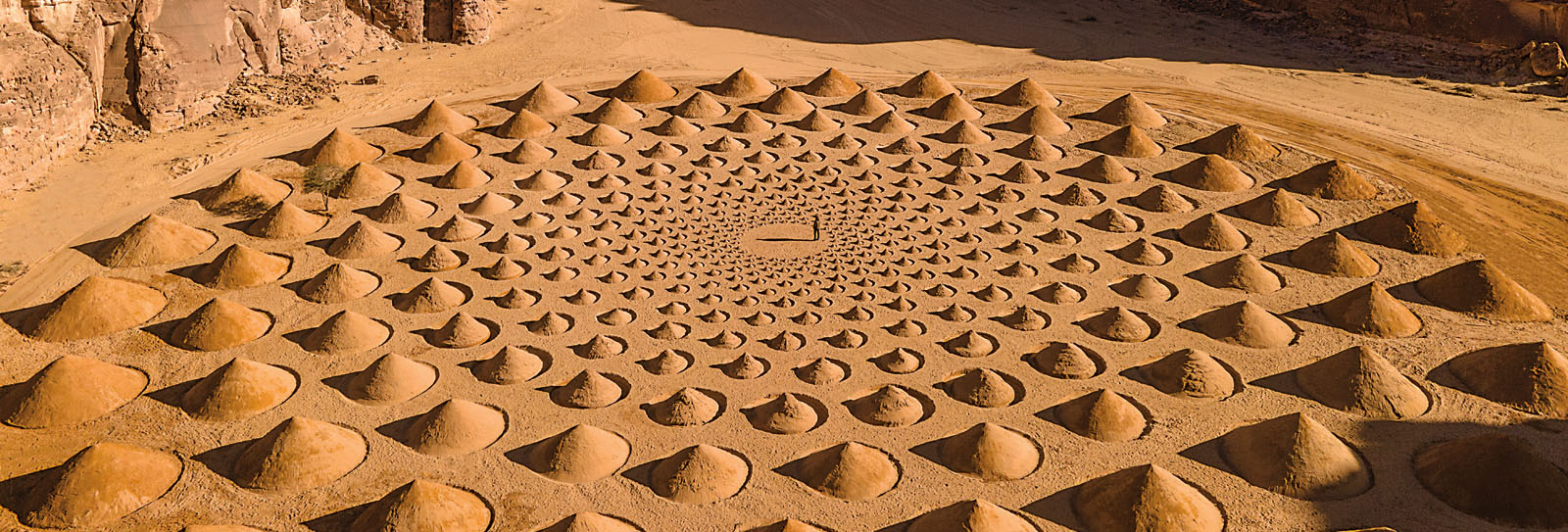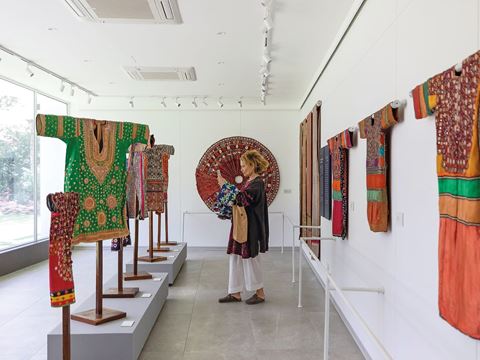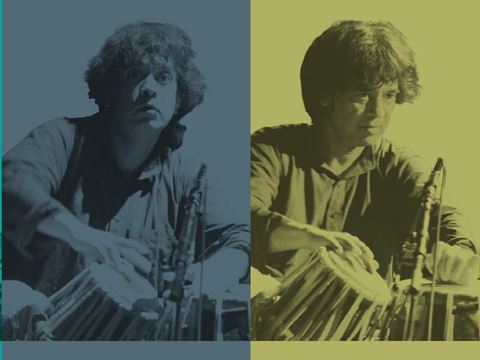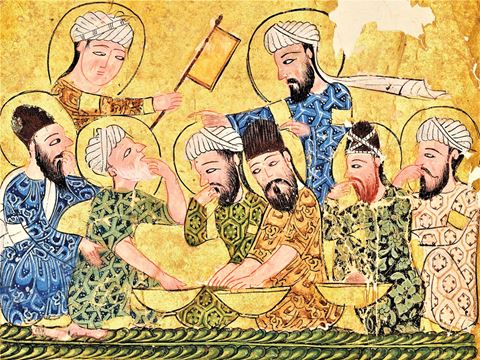
Kingdom of Art
In less than a decade, Saudi Arabia has emerged as one of the world's fastest-growing centers of contemporary art. Both for Saudi artists and international creatives invited to exhibit, install, screen, teach and produce, more than 100 new events sponsored by more than two dozen new arts organizations now offer opportunities across the country. Artists such as Dana Awartani, whose neoclassically symmetrical installation "Where the Dwellers Lay" (above) nestled at the outdoor exhibition Desert X AlUla 2022, and dozens of others are showing at recently opened, large-scale venues, including Riyadh's JAX District, Jiddah's Hayy Jameel cultural center and Red Sea Film Festival, and Dhahran's cultural center, Ithra.
For nearly a decade, Saudi Arabia has pursued a strategy of supporting some of the world’s boldest contemporary art together with an arts scene intent on taking a place alongside more-established world art centers. This has attracted attention from international audiences and curators and, at the same time, played an increasingly important economic role.

Speaking on a panel at Expo 2020 Dubai earlier this year, Albara Al-Auhali, deputy minister of cultural strategies and policies at Saudi Arabia’s National Identity Enhancement Program supporting Riyadh’s new transitional JAX District neighborhood, described well-designed arts districts as reliable boons for communities. They create “job opportunities that help grow and diversify the economy,” he says.
About half of Saudi Arabia’s gross domestic product is generated from the oil and gas sector, which accounts for nearly 70 percent of its export earnings, according to the Organization of the Petroleum Exporting Countries. But over the last six years, since the launch of its Vision 2030, the kingdom has committed to further diversifying its economy, with culture and tourism set to play a central role. The Saudi Ministry of Culture’s Amr AlMadani, chief executive officer for The Royal Commission for AlUla, told the World Economic Forum in 2021 the kingdom’s plan for investing in the arts will contribute to 3 percent of its total GDP by by the end of the decade. This includes investing in art projects and events, expanding the country’s capital projects, implementing more tourism infrastructure and improved access to the UNESCO-designated historical city of al-`Ula, and adding “statement architecture” to major cities.

“Saudi Arabia has been realizing its Vision 2030 reform program—an ambitious plan to diversify the country’s economy, engage local communities, take pride in our heritage, and open up our society to the world.” AlMadani says. “The Royal Commission for AlUla was set up to develop al-`Ula in line with this goals: establishing it as a global destination for culture, heritage and history, with tourism powering a diversified local economy.”
Creative culture and the growth of artistic events has seen a swift uptick in recent years, where other global arts cities gained recognition over a period of many decades. Local Saudi artists have also been welcomed to exhibit alongside international masters, especially in Jiddah and Riyadh, the nation’s economic centers.
“The idea is ... to make Saudi arts and culture professionals become part of the global conversation.”
—Rakan bin Ibrahim Al-Touq


“The idea is to increase Saudi participation in global exchange,” says Rakan bin Ibrahim Al-Touq, general supervisor of cultural affairs and international relations for the Ministry of Culture in a 2021 press release. “To make Saudi arts and culture professionals become part of the global conversation.”
Alauhali and Al-Touq both agree the Kingdom’s growing art scene of domestic and imported virtuosos has matured rapidly over the past seven years. Saudi Arabia now boasts a certain cachet with its variety of cultural events and impressive breadth of exhibited works. In 2021 the Ministry of Culture reported the kingdom hosted 100 cultural events, led by 25 new cultural organizations established by the Ministry of Culture in recent years.
Home for the Arts: Jiddah
Perhaps the best indicator of the kingdom’s artistic blossoming is what one of the world’s leading art curators and strategy consultants, Barbara Römer, calls the “museums-without-walls” approach. Römer launched her creative consultancy and think tank, Studio Römer, in 2014, and she regularly consults on global cultural projects that help cities develop and execute cultural visions and projects. She has been working on projects across the kingdom, and she says the museum-without-walls approach is increasingly prevalent throughout Jiddah.
It’s a philosophy, Römer says, that culminates when cities develop and build based on local culture, which then attracts wider appeal.

“Recent developments in arts and culture in the kingdom have created a transformative catalyst for inspiring conversations in both the local and international context,” says the German-born Römer, who holds a doctorate from Cambridge University and serves as trustee of the Deutsches Museum, the largest science museum in the world.
Jiddah’s commercial center, popular resorts and lush villas have continued to help attract artists and young professionals, and the city has long been regarded as more liberal and relaxed. Jiddah’s longstanding arts culture goes back to the 1980s when the city began sponsoring international sculptors to come create and erect industrial, outdoor pieces. Today, Jiddah is widely perceived as one of the most open cities in the kingdom, and home to 4.5 million residents, up from 1.4 million in 1970, according to UN-Habitat, with many under 30 years old.
A favorite building is the Hayy Jameel cultural center and arts complex, which opened in December 2021. The center self-identifies as a creative community and “home for the arts.” Hayy is an Arabic word meaning neighborhood, and Hayy Jameel boasts 17,000 square-meters of exhibit space and a brightly colored exterior resembling a 1980s color block art style, with layered patterns of pink, blue, red and yellow shapes and lines, by Saudi artist Nasser Almulhim.

Hayy Jameel’s inaugural exhibition, Staple: What’s on your plate? explored eco-social entanglements with food, which helped establish the cultural center as a space for critical socioeconomic discussion.
“It’s hard to underestimate the seismic shift taking place both in the arts in Saudi right now and in the perception and understanding globally,” says Antonia Carver, director of Art Jameel, which founded Hayy Jameel and supports artistic and creative communities in Saudi Arabia and United Arab Emirates. “Hayy Jameel offers a space and context for year-round international exchange—between institutions, curators, artists, filmmakers, writers, creative practitioners and audiences themselves.”
Jiddah’s Red Sea Film Festival offers another increasingly international draw to the city and has become a prestige destination for progressive cinema. In 2019, Saudis from the international film community began supporting large-scale public film screenings in the kingdom. Enough interest followed, and the Red Sea Film Festival was founded the same year, but the organization wasn’t able to host its first edition until December 2021 due to COVID-19. Its inaugural event drew 30,000 spectators and more than 3,000 industry professionals and press. In addition to showcasing best-in-class film, the festival helps foster up-and-coming Saudi filmmakers. The 2021 festival featured 138 films and shorts from 67 countries produced in 34 languages; 27 films were from Saudi Arabia, according to screendaily.com.

Saudi-born producer Faisal Baltyuor, who formerly served as CEO of the Saudi Film Council and is now CEO of Saudi-based Muvi Studios, says flagship film festivals like Red Sea serve two purposes. The first is to “expose [the kingdom] to the world” and allow global audiences to “see the creative Saudi people.” The second, and perhaps more fundamental purpose, is to nurture local talent and production houses. The Red Sea Film Fund to date has invested $14 million into Arab and African productions. Red Sea will host its second festival the first week of December 2022.
“Over the past year, a real collaborative spirit has emerged and a sense of an extended ecology across the Kingdom. … International visitors have revelled in being able to absorb something of the great diversity that the kingdom and its growing arts scene offer,” Römer says.
Cultural Capital: Riyadh
Home to 7.5 million people and for the past decade growing at 2 percent a year, Saudi Arabia’s capital is one of the world’s fastest-growing cities. Similar to Jiddah’s cultural development, Riyadh’s initiatives in recent years have effected sweeping changes in its cultural landscape. For example, the Diriyah Biennale Foundation was established in 2020, and it held its inaugural Diriyah Contemporary Art Biennale from December 2021 to March of this year. It set out to cultivate global dialog among diverse art communities abroad and throughout Saudi Arabia while also highlighting the country’s Islamic roots through contemporary art. The first biennale was located in the JAX District near al-Dir’iyah, the historic founding place of Saudi Arabia. The JAX District, established in 2007 and brought to fruition 10 years later, has transformed nearly 100 warehouses into a sprawling region for local and international art organizations, companies, programs, exhibitions and individual artists. The district is geared toward becoming a wellspring of cultural value for Riyadh, reminiscent of similar postindustrial art neighborhoods and spaces such as Shanghai’s M50, Dubai’s Alserkal Avenue and London’s Canary Wharf.



The now-flourishing art scene in Riyadh owes much of its expansion to the Misk Art Institute, launched in 2011, a cultural nonprofit and a first-mover in the latest developments of Saudi Arabian art. Host of the week-long Misk Art Week, now in its sixth edition and occurring annually the first week of December, the institute spearheads efforts to tackle contemporary themes and promote international cultural relations by nurturing local talent through its offerings of grants and residency programs. The institution continues to increase opportunities to welcome international audiences also, with last year’s Misk Art Week receiving 3,500 attendees on-site and 90,000 globally via virtual conference.
These among other events have helped attract other international attention to Riyadh, which hosted the 2019 edition of the roaming Argentinian festival of BIENALSUR, the International Contemporary Art Biennial of South America. The city’s new cultural spaces have also allowed for homegrown events, including the Riyadh Art Festival—launched in 2019 as the nation’s first large-scale public art initiative—and the Tuwaiq International Sculpture Symposium, which invited 20 international sculptors in 2021 to craft a series of permanent artworks to be enjoyed by the public for generations to come.
Al-’Ula and Beyond
Amid the arid sands and valleys of the kingdom’s northwest corner, the second international art exhibition of Desert X AlUla recently concluded in March, in the historic city of al-`Ula, located about three hours north of Madinah. The event is a collaboration between Desert X, a California-based not-for-profit, and the Royal Commission for AlUla in Saudi Arabia. Desert X is to celebrate the significance of unique desert landscapes worldwide, incorporating voices from international artistic communities. Neville Wakefield, Desert X artistic director and cocurator of the AlUla exhibition, says the “huge reservoir of prospect and talent within the region” are finally being given a proper platform to showcase their works due to “the rapidity of transformation in every aspect of culture and development.” The event, he says, provides a platform for international artists, especially Saudi artists who can be “exposed to art in ways that don’t conform to the largely Western architectural canon.”
“Young people in Saudi Arabia are hungry for the very best in arts and culture, so it is important to feed this appetite with work of the highest caliber.”
—Nora Aldabal
Desert X AlUla has brought the historically prominent locale onto the radar of international art enthusiasts, and the Royal Commission for AlUla’s long-term masterplan for the region, Journey Through Time, outlines 15 new landmark destinations in the region for exhibitions on culture, heritage and creativity before 2035. The plan includes establishing five distinct districts, each as a cultural landmark for tourism. Nora Aldabal, executive director of arts and creative industries for the Royal Commission for AlUla, says the efforts will help “invigorate a vibrant cultural economy” and create a “global platform for Saudi artists.”
The city of Dhahran, in the Eastern Province of the kingdom, also ignited a cultural flame in 2018 with the opening of the King Abdulaziz Center for World Culture—Ithra, an expansive, multifunctional 80,000 square-meter facility boasting spaces for exhibitions, cinema, theater, intellectual activity and cultural incubation. With developments in arts and culture expanding beyond the country’s major cities, international interest continues to support and attract top talent to the region. Ithra receives about a million visitors every year of which 17 percent, or 170,000, hail from outside the kingdom.


Creating an Artistic Oasis
These financial investments in the arts are also helping encourage a more open society and tourism. They’re creating “new cultural ecosystems,” Römer says, arguing that the importance of this moment in contemporary Saudi art should not be underestimated. The pieces “celebrate and value creative pursuits, and that allows artists to experiment, to explore, also to fail, in order to ultimately find and hone their authentic voices.”
In addition to shining much-deserved spotlights on Saudi artists, both residing in the kingdom and abroad, the rising scene is cultivating conditions for new talent. Most exciting, Aldabal says, is that the new wave appears far from cresting.
“Young people in Saudi Arabia are hungry for the very best in arts and culture, so it is important to feed this appetite with work of the highest caliber,” she says.
Stepping out so quickly onto the contemporary world stage of art and culture will surely bring its challenges, but what’s emerging is recognition of a vibrant new arts scene, one that showcases diverse artistic cultures and styles that have roots centuries deep.
You may also be interested in...

Nasreen ki Haveli: Pakistani Textile Museum Fulfills a Dream
Arts
Collector Nasreen Askari and her husband, Hasan, have turned their home into Pakistan’s first textile museum.
Zakir Hussain Played Tabla in Indian Classical Music and Beyond
Arts
While mastery of Indian musical traditions is one clear accomplishment, the late Zakir Hussain’s bold pursuit of his art across genres likely best defines his legacy.
Smorgasbords of Andalusi and Mahgribi Dishes, a Conversation With Food Historian and Author Nawal Nasrallah
Arts
In Smorgasbords of Andalusi and Mahgribi Dishes, Arab food historian Nawal Nasrallah breathes new life into an anonymously compiled 13th-century cookbook.